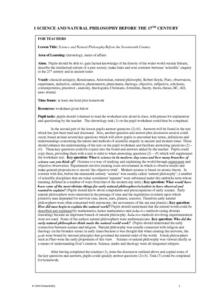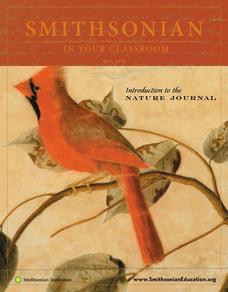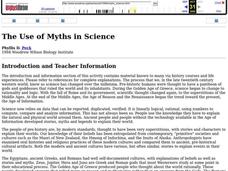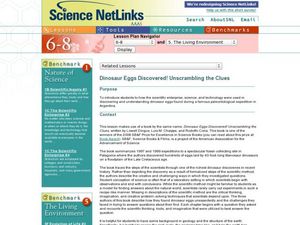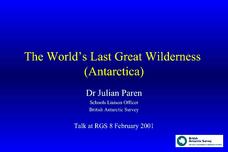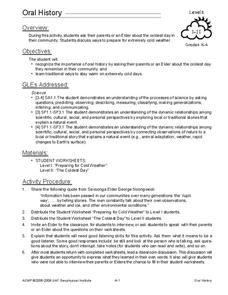Curated OER
Wind Power
What a wonderful way to explore wind power! Through this instructional activity, learners get a background in the history of wind power, create their own wind turbine, and the test their designs. This is a terrific way to tie scientific...
Towson University
Mystery Disease
How did scientists determine the cause of illness before technology? Science scholars play the role of medical researcher in an engaging guided inquiry activity. Using observations, technical reading, and Punnett squares, learners...
Curated OER
Science and Natural Philosophy Before the Seventeenth Century
Students complete a worksheet about some of the natural philosophers in history. They use graph paper and create a timeline with the dates of birth and names of a list of natural philosophers. They list four questions concerning life and...
Curated OER
Introduction to the Nature Journal
Students create nature journals. For this introduction to the nature journal lesson, students discover the uses of nature journals and begin their own. Students are challenged to use vivid, concise terms in their descriptive language....
Curated OER
The Wilderness Concept: Our National Parks, History and Issues
Students examine the history of the National parks. In groups, they discuss the concepts of conservation and preservation. They discuss the use of natural resources and how some are renewable and non-renewable. To end the lesson plan,...
Curated OER
The Use of Myths in Science
Students examine folk tales to determine the basis for scientific myths. They demonstrate through the discussion of the folk tales that the perception of the world has changed as new information is gained. They write their own folk...
Curated OER
AIDS: A Pop Culture History
Students watch the documentary AIDS: A Pop Culture History and discuss the issues the documentary raises. Students discuss the different facts and myths about AIDS, discuss stereotypes in relation to the disease and discuss common fears...
Curated OER
Geologic History of Long Island Sound
In this geologic history of Long Island Sound worksheet, students read about how the Long Island sound was formed through rivers and glaciers advancing and retreating. Students answer 5 questions about the reading and the formation of...
Curated OER
Dinosaur Eggs Discovered! Unscrambling the Clues
Just a heads up: this activity is based on a book, Dinosaur Eggs Discovered! Unscrambling the Clues. If you do not have or do not want to purchase the book, you may still find the other activities and worksheets useful in your earth...
Curated OER
The World's Last Great Wilderness (Antarctica)
It's a shame that there are no photographs in this presentation because the information is fascinating! Each identically fashioned slide contains bullet points of information about Antarctica that will enhance an earth science...
National Research Center for Career and Technical Education
Health Science: Back to Basics
This lesson focuses on unit conversion, proportions, ratios, exponents, and the metric system. Discuss measurement with your math class and demonstrate how to solve several health-science word problems. Give learners a chance to visit an...
Curated OER
Readings in Hudson River Natural History
Reading and understanding informational text is a key element to understanding every discipline. Elementary learners read three different articles focused on various animals and habitats in the Hudson River. They answer comprehension...
National Park Service
The Young Naturalist
Beginning with a brief history of our 26th president, Theodore Roosevelt, then followed by a discussion of his interest in nature, young scientists take to the outdoors to locate and observe local plants and insects....
Channel Islands Film
Lone Woman of San Nicolas Island: Lesson Plan 4
Imagine being stranded all alone on an island for 18 years. How would you survive? Class members are challenged to makes necessities out of natural materials that would likely be found on an island.
Virginia Department of Education
DNA Structure, Nucleic Acids, and Proteins
What is in that double helix? Explain intricate concepts with a variety of creative activities in a lesson plan that incorporates multiple steps to cover DNA structure, nucleic acids, and proteins. Pupils explore the history of DNA...
Virginia Department of Education
The Germ Theory and Koch’s Postulates
Explore the history of cholera and its effect on society with your biology class. Young biologists will then proceed to grow their own germs, prepared from live cultures, and follow the steps of the scientific method to generate data....
Curated OER
Oral History
Students interview a Native Elder to learn about oral history and cold weather. In this weather instructional activity, students ask an Elder about the coldest day they remember in their community and complete two worksheets for the topic.
Curated OER
Evolution: Natural Selection
Young scholars analyze and discuss the evolutionary history of dinosaurs. In this investigative lesson students monitor different organisms in the environment and analyze the pressures that affect the chances of survival.
Curated OER
History of Natural Resources in the U.S.
Students define conservation, exploitation and preservation, identify legislation related to conservation and environmental issues, and identify leaders and organizations that were key to the conservation and environmental movements.
Curated OER
Nature Rules In The Great Flood of 1993
Pupils examine the event of the Great Flood of 1993. Using the internet, they research the economic, social and ecological changes that impacted the area. They conduct a town meeting in which they debate the positives and negatives of...
Curated OER
An Introduction to Modern Economics
Practice reading comprehension with this informational economics instructional activity. Learners read a 2-page explanation of the beginnings of modern economics and how it plays a role in society. This reading discusses natural, human...
Curated OER
Kernels of Wisdom: Investigating Natural Variations in Corn
Here is a brain-popper! Corn, or more appropriately, maize, was intentionally domesticated by humans around 9,000 years ago and over a period of hundreds to thousands of years! Genetics and botany researchers have collaborated to find...
Curated OER
Environmental Changes
High school scientists reasearch and illustrate changes in the local environment and consider relationships among agriculture, industry, economy, natural events, and social interactions. They construct a timeline to discover if there are...
Curated OER
Watershed Documentary
Students research and produce an iMovie documentary about the human and natural history of a stream basin (watershed).




